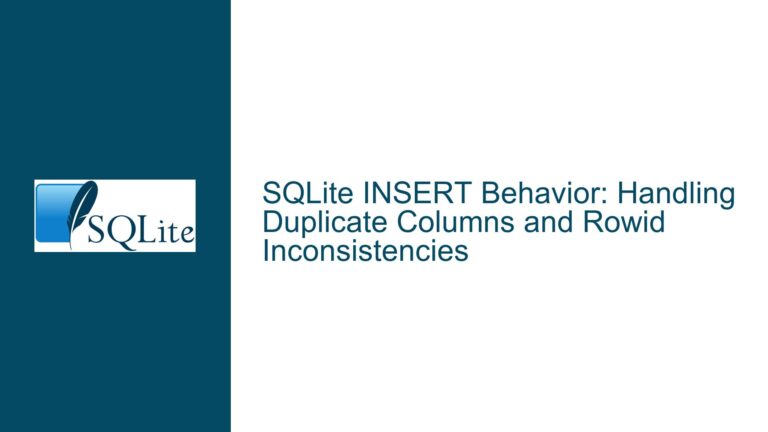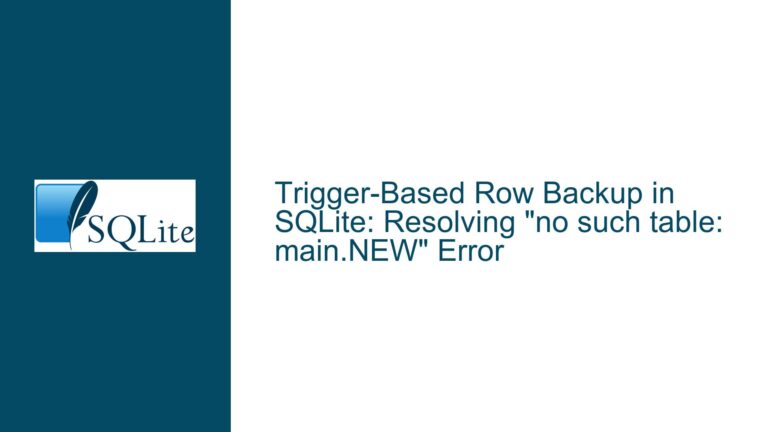Resolving Unique Constraint Violations During Sequential Updates in SQLite
Understanding the Problem of Sequential Updates and Unique Constraint Violations
When working with SQLite, particularly in scenarios where you need to maintain a sequence of integers in a column (such as an ord column representing the order of nodes in a directed acyclic graph), you may encounter unique constraint violations. These violations typically occur when you attempt to update multiple rows in a way that temporarily creates duplicate values in a column that must remain unique.
In the context of the provided schema, the outline table has an ord column that serves as both the primary key and a sequential identifier. The requirement is that the ord values must be contiguous, with no gaps, and must cover the range from 0 to the number of nodes in the outline. When inserting new nodes into the middle of this sequence, you need to shift the existing ord values to create space for the new entries. However, this shifting process can lead to temporary duplicates, which violate the unique constraint on the ord column.
For example, if you have a sequence of ord values like [1, 2, 3, 4, 5] and you want to insert a new node at position 3, you need to shift the existing values from 3 onwards to [4, 5, 6]. However, if you attempt to update the rows in ascending order, you might first set ord=4 for the row that previously had ord=3. At this point, both the row that originally had ord=4 and the row that now has ord=4 would temporarily have the same value, leading to a unique constraint violation.
Why Standard Update Queries Fail to Maintain Unique Constraints
The core issue arises from the way SQLite processes updates. By default, SQLite does not guarantee the order in which rows are updated when you issue an UPDATE statement. This means that if you attempt to update multiple rows in a single query, SQLite might process them in an order that leads to temporary duplicates, even if you specify an ORDER BY clause. The ORDER BY clause in an UPDATE statement only affects the order in which rows are selected for updating, not the order in which the updates are applied.
For instance, consider the following query:
UPDATE outline SET ord = ord + 2 WHERE ord >= 11 ORDER BY ord DESC;
While the ORDER BY ord DESC clause ensures that the rows are selected in descending order, SQLite might still apply the updates in an arbitrary order. This can result in a situation where a row with ord=11 is updated to ord=13 before the row with ord=13 is updated to ord=15, leading to a temporary duplicate value of 13.
Leveraging SQLite’s ON CONFLICT Clause to Avoid Unique Constraint Violations
To avoid these unique constraint violations, you can use SQLite’s ON CONFLICT clause in combination with an INSERT statement. The ON CONFLICT clause allows you to specify what should happen when a conflict arises (e.g., when a unique constraint is violated). By using this clause, you can effectively "bump" existing rows out of the way to make space for new entries.
The key idea is to use an INSERT statement with a SELECT clause to generate the new ord values, and then use the ON CONFLICT clause to handle any conflicts that arise. Here’s how it works:
Select the Rows to be Updated: Use a
SELECTstatement to identify the rows that need to be updated. In this case, you want to select all rows whereordis greater than or equal to the position where you want to insert the new node.Generate New
ordValues: Use theSELECTstatement to generate newordvalues for these rows. For example, if you want to shift the rows by 2 positions, you can add 2 to the existingordvalues.Handle Conflicts with
ON CONFLICT: Use theON CONFLICTclause to specify what should happen if a conflict arises. In this case, you want to update the conflicting row by incrementing itsordvalue.
Here’s an example of how this can be done:
INSERT INTO outline (ord)
SELECT ord
FROM outline
WHERE ord >= 11
ORDER BY ord DESC
ON CONFLICT (ord) DO UPDATE
SET ord = excluded.ord + 2;
In this query:
- The
SELECTstatement selects all rows whereord >= 11and orders them in descending order. - The
INSERTstatement attempts to insert these rows with theirordvalues incremented by 2. - If a conflict arises (i.e., if a row with the new
ordvalue already exists), theON CONFLICTclause updates the conflicting row by incrementing itsordvalue by 2.
This approach ensures that the updates are applied in a way that avoids temporary duplicates, thus preventing unique constraint violations.
Implementing the Solution: Step-by-Step Guide
To implement this solution in your application, follow these steps:
Identify the Insertion Point: Determine the position (
ordvalue) where you want to insert the new node(s). For example, if you want to insert new nodes at position 11, you need to shift all rows withord >= 11by the number of new nodes you are inserting.Shift Existing Rows: Use the
INSERT ... ON CONFLICTapproach to shift the existing rows. For example, if you are inserting 2 new nodes, you would shift the existing rows by 2 positions:INSERT INTO outline (ord) SELECT ord FROM outline WHERE ord >= 11 ORDER BY ord DESC ON CONFLICT (ord) DO UPDATE SET ord = excluded.ord + 2;Insert the New Nodes: After shifting the existing rows, you can insert the new nodes at the desired positions. For example:
INSERT INTO outline (ord, p, level, gnx, expanded, marked) VALUES (11, 12345, 7, 'g187', 0, 0), (12, 67890, 8, 'g175', 0, 0);Verify the Results: After performing the updates and inserts, verify that the
ordvalues are contiguous and that there are no gaps or duplicates. You can do this by running aSELECTquery:SELECT ord FROM outline ORDER BY ord;
Handling Edge Cases and Optimizations
While the above solution works well for most cases, there are some edge cases and optimizations to consider:
Handling Large Tables: If your table is very large, the
INSERT ... ON CONFLICTapproach might be slow because it involves updating many rows. In such cases, you can optimize the process by using a temporary table to store the newordvalues and then applying the updates in bulk.Handling Negative
ordValues: If your table contains rows with negativeordvalues, you need to ensure that the shifting process does not interfere with these rows. You can do this by adding a condition to exclude negativeordvalues from the update:INSERT INTO outline (ord) SELECT ord FROM outline WHERE ord >= 11 AND ord > 0 ORDER BY ord DESC ON CONFLICT (ord) DO UPDATE SET ord = excluded.ord + 2;Handling Concurrent Updates: If your application involves concurrent updates to the
outlinetable, you need to ensure that the shifting process is atomic. You can do this by wrapping the updates in a transaction:BEGIN IMMEDIATE; -- Shift existing rows INSERT INTO outline (ord) SELECT ord FROM outline WHERE ord >= 11 ORDER BY ord DESC ON CONFLICT (ord) DO UPDATE SET ord = excluded.ord + 2; -- Insert new nodes INSERT INTO outline (ord, p, level, gnx, expanded, marked) VALUES (11, 12345, 7, 'g187', 0, 0), (12, 67890, 8, 'g175', 0, 0); COMMIT;
Conclusion
Maintaining a contiguous sequence of integers in a SQLite table while avoiding unique constraint violations can be challenging, especially when inserting new rows into the middle of the sequence. However, by leveraging SQLite’s ON CONFLICT clause and carefully ordering your updates, you can achieve this without resorting to inefficient workarounds like double-renumbering. The key is to shift existing rows in a way that avoids temporary duplicates, and the INSERT ... ON CONFLICT approach provides an elegant solution to this problem. By following the steps outlined in this guide, you can ensure that your ord values remain contiguous and unique, even as you insert new nodes into your directed acyclic graph.






